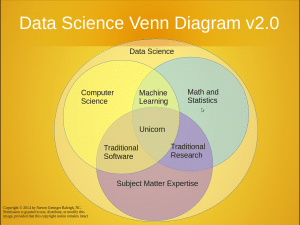Four Data Science Imperatives for Customer Success Executives
- by 7wData

Business growth depends on ensuring customers recommend, stay and expand their relationship with you. Businesses are implementing customer success management (CSM) programs to help improve their relationship with customers to improve their chances of success. In our Big Data world, Customer Success Management (CSM) programs are now able to leverage large amounts of Customer data to help them better understand their customers’ needs to decrease customer churn and increase up/cross-selling opportunities. In today’s post, I will discuss the intersection of Big Data and CSM and illustrate how the adoption of data science practices can improve how CS personnel can improve the health of the customer relationship.
We live in a world of Big Data where everything is quantified, where technological advances makes it easy to collect vast amounts of data. For businesses, these data include customer satisfaction ratings of product quality, real product usage metrics as well as customers’ interactions with the company. But those data are not valuable by themselves.
Big Data is less about the data itself and more about what you do with the data. Gil Press offers a great summary of the field of data science. He traces the literary history of the term (term first appears in use in 1974) and settles on the idea that data science is a way of extracting insights from data using the powers of computer science and statistics applied to data from a specific field of study.
In a study of data scientists, we found that data science skills fall into three broad areas (see Figure 1):
A data project is more successful when you can bring these three skills to bear on the problem.
Customer Success Management (CSM) is the process of ensuring customers and users receive value from your solutions. CSM is integral to the success of SaaS companies, where customers are not locked into long-term contracts and can leave at any time. Increasing customers’ perceived value of your solutions will lead to lower churn rates and improve your chances of expanding the adoption of your solutions within Accounts.
Last year, I attended the Customer SuccessCon in Seattle to learn more about the field of customer success management. The conference was led by Mikael Blaisdell, Executive Director of The Customer Success Association. Mikael presented preliminary results of an upcoming report on the state of Customer Success Management (he’ll be publishing this report soon). He mentioned that:
So, while data plays a significant role in customer success management, CS programs are not adequately leveraging either the technology or data science practices to get the most value from their data. Here are five ways businesses can improve the effectiveness of their CSM program.
Customer success managers need to make sense of customer information. Unfortunately, that information is housed in different systems, requiring the CS professionals to collect and aggregate it, taking time away from CS activities that improve the customer relationship. For example, businesses use Google Analytics to understand customers’ search behavior. They leverage Mixpanel to learn how customers use their applications. They rely on Marketo to track the effectiveness of different forms of communication. They rely on Salesforce to track customer interactions across throughout the lifecycle. The use of these separate tools results in data silos, each one housing a particular piece of the customer puzzle.
Analyzing each data source separately is limited by the variables in each data set. To get the complete picture of your customers, you need to connect the dots across the data silos. By integrating all your data, you will be able to analyze all your data to extract deeper insights into the causes of customer churn.
To decrease customer churn, you can use predictive modeling to identify the variables that are predictive of customer churn.
[Social9_Share class=”s9-widget-wrapper”]
Upcoming Events
From Text to Value: Pairing Text Analytics and Generative AI
21 May 2024
5 PM CET – 6 PM CET
Read More


